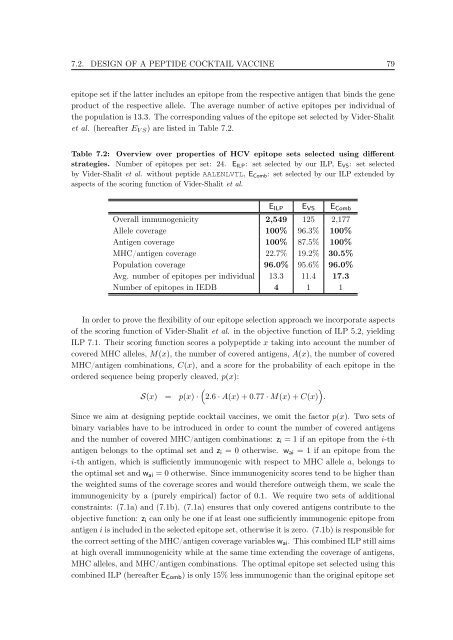New Approaches to in silico Design of Epitope-Based Vaccines
New Approaches to in silico Design of Epitope-Based Vaccines
New Approaches to in silico Design of Epitope-Based Vaccines
You also want an ePaper? Increase the reach of your titles
YUMPU automatically turns print PDFs into web optimized ePapers that Google loves.
7.2. DESIGN OF A PEPTIDE COCKTAIL VACCINE 79<br />
epi<strong>to</strong>pe set if the latter <strong>in</strong>cludes an epi<strong>to</strong>pe from the respective antigen that b<strong>in</strong>ds the gene<br />
product <strong>of</strong> the respective allele. The average number <strong>of</strong> active epi<strong>to</strong>pes per <strong>in</strong>dividual <strong>of</strong><br />
the population is 13.3. The correspond<strong>in</strong>g values <strong>of</strong> the epi<strong>to</strong>pe set selected by Vider-Shalit<br />
et al. (hereafter EV S) are listed <strong>in</strong> Table 7.2.<br />
Table 7.2: Overview over properties <strong>of</strong> HCV epi<strong>to</strong>pe sets selected us<strong>in</strong>g different<br />
strategies. Number <strong>of</strong> epi<strong>to</strong>pes per set: 24. EILP: set selected by our ILP, EVS: set selected<br />
by Vider-Shalit et al. without peptide AALENLVTL, EComb: set selected by our ILP extended by<br />
aspects <strong>of</strong> the scor<strong>in</strong>g function <strong>of</strong> Vider-Shalit et al.<br />
EILP EVS EComb<br />
Overall immunogenicity 2,549 125 2,177<br />
Allele coverage 100% 96.3% 100%<br />
Antigen coverage 100% 87.5% 100%<br />
MHC/antigen coverage 22.7% 19.2% 30.5%<br />
Population coverage 96.0% 95.6% 96.0%<br />
Avg. number <strong>of</strong> epi<strong>to</strong>pes per <strong>in</strong>dividual 13.3 11.4 17.3<br />
Number <strong>of</strong> epi<strong>to</strong>pes <strong>in</strong> IEDB 4 1 1<br />
In order <strong>to</strong> prove the flexibility <strong>of</strong> our epi<strong>to</strong>pe selection approach we <strong>in</strong>corporate aspects<br />
<strong>of</strong> the scor<strong>in</strong>g function <strong>of</strong> Vider-Shalit et al. <strong>in</strong> the objective function <strong>of</strong> ILP 5.2, yield<strong>in</strong>g<br />
ILP 7.1. Their scor<strong>in</strong>g function scores a polypeptide x tak<strong>in</strong>g <strong>in</strong><strong>to</strong> account the number <strong>of</strong><br />
covered MHC alleles, M(x), the number <strong>of</strong> covered antigens, A(x), the number <strong>of</strong> covered<br />
MHC/antigen comb<strong>in</strong>ations, C(x), and a score for the probability <strong>of</strong> each epi<strong>to</strong>pe <strong>in</strong> the<br />
ordered sequence be<strong>in</strong>g properly cleaved, p(x):<br />
<br />
<br />
S(x) = p(x) · 2.6 · A(x) + 0.77 · M(x) + C(x) .<br />
S<strong>in</strong>ce we aim at design<strong>in</strong>g peptide cocktail vacc<strong>in</strong>es, we omit the fac<strong>to</strong>r p(x). Two sets <strong>of</strong><br />
b<strong>in</strong>ary variables have <strong>to</strong> be <strong>in</strong>troduced <strong>in</strong> order <strong>to</strong> count the number <strong>of</strong> covered antigens<br />
and the number <strong>of</strong> covered MHC/antigen comb<strong>in</strong>ations: zi = 1 if an epi<strong>to</strong>pe from the i-th<br />
antigen belongs <strong>to</strong> the optimal set and zi = 0 otherwise. wai = 1 if an epi<strong>to</strong>pe from the<br />
i-th antigen, which is sufficiently immunogenic with respect <strong>to</strong> MHC allele a, belongs <strong>to</strong><br />
the optimal set and wai = 0 otherwise. S<strong>in</strong>ce immunogenicity scores tend <strong>to</strong> be higher than<br />
the weighted sums <strong>of</strong> the coverage scores and would therefore outweigh them, we scale the<br />
immunogenicity by a (purely empirical) fac<strong>to</strong>r <strong>of</strong> 0.1. We require two sets <strong>of</strong> additional<br />
constra<strong>in</strong>ts: (7.1a) and (7.1b). (7.1a) ensures that only covered antigens contribute <strong>to</strong> the<br />
objective function: zi can only be one if at least one sufficiently immunogenic epi<strong>to</strong>pe from<br />
antigen i is <strong>in</strong>cluded <strong>in</strong> the selected epi<strong>to</strong>pe set, otherwise it is zero. (7.1b) is responsible for<br />
the correct sett<strong>in</strong>g <strong>of</strong> the MHC/antigen coverage variables wai. This comb<strong>in</strong>ed ILP still aims<br />
at high overall immunogenicity while at the same time extend<strong>in</strong>g the coverage <strong>of</strong> antigens,<br />
MHC alleles, and MHC/antigen comb<strong>in</strong>ations. The optimal epi<strong>to</strong>pe set selected us<strong>in</strong>g this<br />
comb<strong>in</strong>ed ILP (hereafter EComb) is only 15% less immunogenic than the orig<strong>in</strong>al epi<strong>to</strong>pe set

















